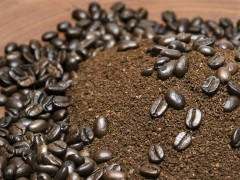Features
Wake up and smell the coffee
Date: 2017-05-16 09:25:23.0
Author: Jon Evans

Numerous studies have demonstrated the potential of agricultural and food waste as a biofuel feedstock, but realizing that potential has proved more challenging. The problem is not so much in finding processes for transforming agricultural and food waste into biofuels, but in making these processes sufficiently efficient for large-scale commercial development. Two recent studies have now gone some way towards doing that.
Spent coffee grounds are one type of food waste that studies have shown could make an effective biofuel feedstock, as they comprise up to 20% lipids, with several research groups having successfully converted these lipids into a useable biodiesel. The problem is that these groups have tended to employ a two-step process in which the lipids are first extracted from the coffee with a solvent such as hexane and then converted into biodiesel via a transesterification reaction, which is all rather expensive.
Now, a team of scientists at Lancaster University in the UK, led by Vesna Najdanovic-Visak, has shown that, under the right conditions, the hexane step can be discarded. The lipids can then be extracted and converted by simply mixing the coffee grounds directly with the methanol and catalytic sodium hydroxide required for the transesterification reaction. As they report in the Journal of Environmental Chemical Engineering, Najdanovic-Visak and her team achieved the best results when heating the coffee grounds at 60°C with a methanol-to-oil ratio of 400 and 0.2mol/L of sodium hydroxide for 90 minutes. This succeeded in converting 96% of the lipids in the grounds into biodiesel.
“Our method vastly reduces the time and cost needed to extract the oils for biofuel making spent coffee grounds a much more commercially competitive source of fuel,” said Najdanovic-Visak. “A huge amount of spent coffee grounds, which are currently just being dumped in landfill, could now be used to bring significant environmental benefits over diesel from fossil fuel sources.”
A less pleasant waste than spent coffee grounds are chicken droppings, which are notoriously smelly. Like other animal waste, though, chicken droppings can theoretically be converted into biogas via anaerobic digestion. Unfortunately, this process doesn’t work too well with chicken droppings because they contain comparatively high concentrations of ammonia, which inhibits microbial digestion. One solution is to combine the droppings with plant biomass to enhance the carbon content and thus reduce the ammonia concentration, and scientists have shown that this works with plants such as maize, sugar beet and switchgrass.
Clearly, though, maize and sugar beet are too valuable to be mixed with chicken droppings on a large scale, and even switchgrass can be put to better uses. What is needed is a plant that grows widely but has no practical uses; even better if the plant is an invasive weed that really needs to be removed anyway. A team of Nigerian scientists led by Samuel Dahunsi at Landmark University has now found just such a plant in the Mexican sunflower (Tithonia diversifolia), which was initially introduced to West Africa as an ornamental plant but has since spread to become a serious weed in crops.
As Dahunsi and his team report in Energy & Fuels, adding T. diversifolia to chicken droppings greatly enhanced the anaerobic digestion process, allowing 8kg of poultry waste and sunflowers to be converted into 3kg of biogas. Once again, sodium hydroxide was central to the process: this enhanced rate was obtained after the T. diversifolia was partially broken down by heating it with sodium hydroxide before mixing it with the chicken droppings. This increased the biogas yield by over 50%, more than sufficient to cover the energy required for the pre-treatment process.
As an added advantage, the material left over after the anaerobic digestion contained high concentrations of nutrients such as nitrogen, phosphorus and potassium, meaning it could make an effective fertilizer for growing crops such as coffee.
The views represented here are solely those of the author and do not necessarily represent those of John Wiley and Sons, Ltd. or of the SCI.
Displaying 8 keywords used to tag this article:
- Moncler Mens Tib Quilted Slim Down
- Meisterstuck Rollerball : Discount
- Fake Modern Tag Heuer Grand Carrera
- Christian Louboutin Fifi 80mm pumps
- Jimmy Choo Schuhe Preis | Discount
- Copy Omega Watches Aqua Terra Jewel
- Replica [ Germany ] A Lange Sohne D
- luxury watches replica
